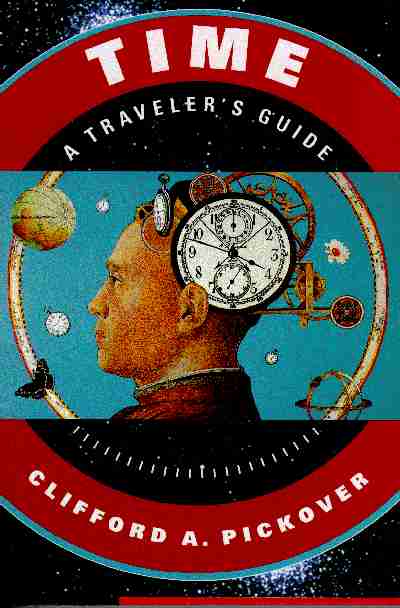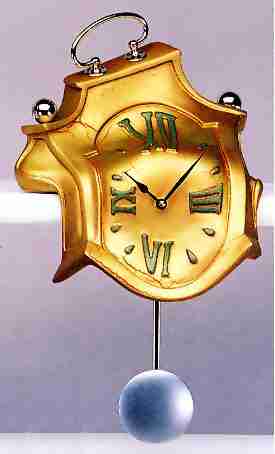Contact |
News! |
Books |
Home |
Contact |
News! |
Books |
Home |

|
Praise"Only Clifford Pickover would think of mixing time travel and music. Gripping, clear -- this book could well be his best yet! A must buy for all wannabe time travelers."- Ian Stewart, Scientific American "It is impossible to read Clifford Pickover's latest book
without learning a great deal about modern physics, and at the same time
being overwhelmed by the impenetrable mystery of time and its role in those
other two dark mysteries, consciousness and free will. As always, the author's
pages are exciting, entertaining, and a delight to read.
"Cliff Pickover explores most aspects of the implausible
prospects of practical time travel. If not a visitor from the future, he's
at least a man ahead of his time."
"Time: A Traveler's Guide is certain to shed new light,
raise new questions, and make your mind reel over the ancient and illusive
concept of time."
"The arrow of time and our understanding of it defines
much of our humanity. Whether it be correcting past mistakes, regaining
lost youth, or leaning what comes next, everyone yearns to overcome the
consequence of time. Traveling through time creates enormous paradoxes,
but modern physical theories do no eliminate the possibility. In this book,
Clifford Pickover presents those theories in layman's terms. To understand
time is to know the ambitions of humans, something Pickover excels at."
|

|
Jacket Blurb"Bucky Fuller thought big," Wired magazine recently noted, "Arthur C. Clarke thinks big, but Cliff Pickover outdoes them both." And now, in his newest book, Cliff Pickover outdoes even himself, probing a mystery that has baffled mystics, philosophers, and scientists throughout history -- What is the nature of time?In Time: A Traveler's Guide, Pickover takes readers to the forefront of science as he illuminates the most mysterious phenomenon in the universe--time itself. Is time travel possible? Is time real? Does it flow in one direction only? Does it have a beginning and an end? What is eternity? These are questions that Pickover tackles in this stimulating blend of Chopin, philosophy, Einstein, and modern physics, spiced with diverting side-trips to such topics as the history of clocks, the nature of free will, and the reason gold glitters. Pickover includes numerous diagrams so readers have no trouble following along, computer code that lets us write simulations for various aspects of time travel, and an on-going science fiction tale featuring quirky characters who yearn to travel back in time to hear Chopin play in person. By the time we finish this book, we understand such seemingly arcane concepts as space-time diagrams, light cones, cosmic moment lines, transcendent infinite speeds, Lorentz transformations, superluminal and ultraluminal motions, Minkowskian space-times, Goedel universes, closed timelike curves, and Tipler cylinders. We'll understand how the brain impacts our perception of time, and be able to perform experiments on your computer... And most important, we will understand that time travel need not be confined to myth, science fiction, Hollywood fantasies, or scientific speculation. Time travel, we will realize, is possible. More information on Cliff Pickover can be found here. |
 "H.G. Wells, call your office! Pickover has stolen your time
machine. Well, not quite. But he does move the concept of time travel out
of wild fantasy into scientific possibility. In an entertaining dialogue
between imaginary characters from the twenty- first century, he draws out
the imaginative and scientific implications of a technology that would
allows us to tunnel back into the past or catapult into the future. Neither
the theoretical prohibition against faster-than-light motion nor the logical
contradiction of rewriting our own history daunts this bold explorer. And
less readers dismiss his speculations too lightly, Pickover appends a "Science
behind the Science Fiction" section to every chapter, marshaling the latest
research on relevant topics. The temporal strangeness of wormholes, quantum
connections, and cosmic strings will unsettle the skeptic and prompt new
wonderings about what it would be like to visit -- or be visited by --
our descendants in future millennia. The intellectual daring of this
book guarantees it a sizable readership now and -- who knows? -- perhaps
in the distant past and future as well. - Bryce Christensen, Booklist,
April 15, 1998
"H.G. Wells, call your office! Pickover has stolen your time
machine. Well, not quite. But he does move the concept of time travel out
of wild fantasy into scientific possibility. In an entertaining dialogue
between imaginary characters from the twenty- first century, he draws out
the imaginative and scientific implications of a technology that would
allows us to tunnel back into the past or catapult into the future. Neither
the theoretical prohibition against faster-than-light motion nor the logical
contradiction of rewriting our own history daunts this bold explorer. And
less readers dismiss his speculations too lightly, Pickover appends a "Science
behind the Science Fiction" section to every chapter, marshaling the latest
research on relevant topics. The temporal strangeness of wormholes, quantum
connections, and cosmic strings will unsettle the skeptic and prompt new
wonderings about what it would be like to visit -- or be visited by --
our descendants in future millennia. The intellectual daring of this
book guarantees it a sizable readership now and -- who knows? -- perhaps
in the distant past and future as well. - Bryce Christensen, Booklist,
April 15, 1998
"If you thought time travel was just for science fiction nuts, think again. As Pickover demonstrates, time travel is not the stuff of Asimovian dreams, it being theoretically possible. Of course, how to travel through time is is no simple matter, nor is explaining it, but Pickover rises to the challenge in many ways. Witty and profound quotations -- from Einstein to Woody Allen -- about time and our relation to it are liberally scattered throughout. Pickover's masterstroke, however, is to divided each chapter into two sections. The first is a second-person narrative recording the impromptu discussions about time-travel of a Chopin-obsessed curator from a Museum of Music with his assistant, "a Zetamorph, a member of a race of philosophers from a subterranean air pocket of Ganymede, a moon of Jupiter" and with a female earthling student. The second section, dutifully labeled "The Science behind the Science Fiction," is a sober essayistic review of topics addressed in the narrative half. Despite the popular tone, Pickover does not shy away from the mathematics of time travel. (He even includes an appendix of programmable algorithms.) A careful reader with some basic science should be able to follow Pickover chapter by chapter . The imaginative and humorous approach makes a difficult subject palatable -- and gives a plug for Chopin at the same time." - Publisher's Weekly, April 20, 1998
"A playful introduction to modern physics from a Discovery magazine columnist.... Frequent references to popular sci-fi movies and stories make the concepts even more accessible to readers. ...The basic principles are clearly explained... An entertaining introduction to modern scientific principles for bright students as well as adults." - Kirkus Review, April 15, 1998
See Pickover books at Amazon.Com in separate window.
See my PBS/NOVA interview on
time
travel in separate window.

Silesius, Angelus, xii Newton, Isaac, xiv-xvi Einstein, Albert, xiv, 37 Wells, H. G., xiv Islam beyond time, xvi Relativity of simultaneity. See Simultaneity Simultaneity, 7-11, 28, 158 Order of events, 11 Davies, Paul, 11, 121 Robb, Alfred, 11 Einstein-Langevin clock, 13-23 Photon clock. See Einstein-Langevin clock Frames of reference, 16, 26, 108 Lorentz-FitzGerald contraction, 17 Krauss, Lawrence, 18, 34 Poincare, Henri, 34 Star Trek, 34 Calendar systems, 19 Herbert, Nick, 122 Time dilation, 14, 116-120. See also Gravitational time dilation. Doppler effect, 117 Mayans, 19 Sumerians, 19 Babylonians, 19 Clocks, 20-21 Atomic clocks, 21 Length contraction, 22-23 Egyptians, 19 Contraction, length, 22-23 Lorentz transformation, 25-45, 100, 143 Proper time, 109, 136 Apparant time, 136 Mass of moving bodies, 27, 33, 124 Scissors, 124 Superluminal motion, 31, 74, 125. See also faster than light; Tachyons Meta-mass, 141 Imaginary mass, 141, 155 Mass, imaginary, 141, 155 Imaginary time, 157 Chronons, 85 Faster than light (FTL), 84, 95, 125. See also Superluminal motion; Tachyons Energy beings, 33 Paradoxes, 34-37, 71-74, 80-83, 110 Twin paradox, 110, 114 Cylindrical spacetime, 114 Spacetime, cylindrical, 114 Heinlein, Robert, 83 Quantum theory, 84 Everett, Hugh, 83 Many-worlds interpretation, 83 Parallel universes, 80-83 Precognitive carousel, 54 Brain's time machine, 47-61 Psychology of time, 47-61 Perception of time, 47-61 Consciousness, 47-61 Hyperland, 57 Infants, 57-58 Drugs, 57-58 Closed spacetime, 112 Spacetime, closed, 112 Here-now in space-time, 63-86, 90 Optical computer, 95 Computer, 95 Hypnosis, 58 Mental illness, 59 Baha'u'llah, 64 Light speed, 94, 150, 154 Elsewhere in space-Time, 63-86 Rules for time travelers Relativity, special theory of, xvi, 37-40 Relativity, general theory of, 39 Spacetime diagrams, 66-70 Light cones, 67-70, 78 Omnipresence, 78, 155 Worldlines, 68, 76-78, 144 Photo worldlines, 144 Future travel, 106-121, 126-127 Travel to future, 106-121, 126-127 Bauer, David, 106 Spacelike events, 70 Timelike events, 79 Gravity, xvi, 39, 115, 136. See also Gravitational time dilation. God, 41-42 Musical scores, 41 Eternitygrams, 42 Rice, Anne, 42 Gravitational time dilation, 39, 131-136. Rotated coordinate system, 99, 143 Black holes, 133-136 Tachyons, 79, 139-158 Intervals, spacetime 98-104, 108 Spacetime intervals, 98-104, 108 distance metric, 98-103, 108 spacetime metric, 108 Minkowskian space, 98-101, 110 Minkowski, Hermann, 104 Spacetime, 105 Riemannian geometry, 101 Flat space, 101, 112 Invariant distance function, 99 Cosmic Moment Lines, 136-158 Transcendent Infinite speeds, 136-158 Hypertime, 40-41 Space, curved, 113 Curved space, 113 Parallel transport, 113 Balloons Strings Kennedy, John, F., 110 Closed timelike curves, 44 Loops, time, 71 Goedelian universes, Wormhole time machine Rotating cylinders Tipler Cylinders, Causality, 49, 125. See also Causality violation Causality violation Causal ordering postulate, 152 Survey, internet Muons, 119-120 Gold, 119-121 Aging, 118, 122 Ultraluminal particles, 146-147 Negative energy, 146-148 Reinterpretation principle (RP), 147-148 Tardyons, 150 Ittyons, 150 Luxons, 151 Cerenkov radiation, 154 Positron, 156 Feynmann, Richard, 156 Science fiction, 158